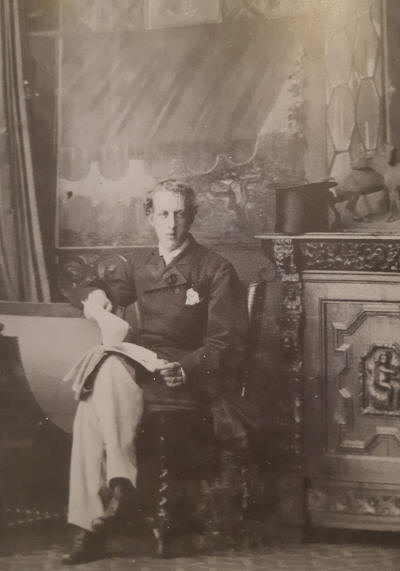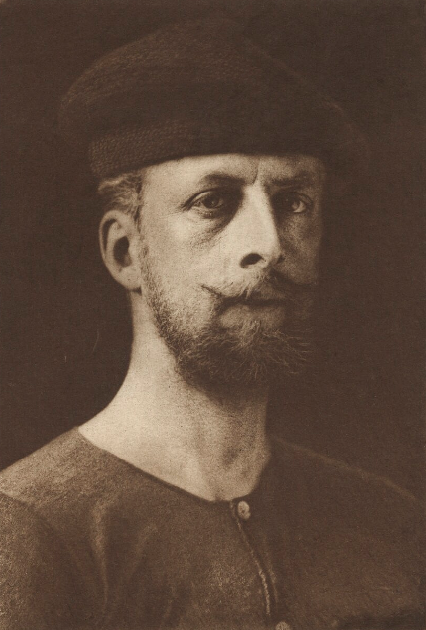BURIED TOGETHER
Partner Frank Hird, buried together
Queer Places:
Stafford House, Stable Yard, St. James's, London SW1A 1BB
Eton College, Windsor SL4 6DW, Regno Unito
University Of Cambridge, Cambridge CB2, Regno Unito
Gower Lodge, 40 Kings Rd, Windsor SL4 2AG
4 Rue de Candolle, 75005 Paris, France
Trentham Estate, Stone Rd, Trentham, Stoke-on-Trent ST4 8JG, UK
Hammerfield Cottage, Penshurst, Tonbridge TN11 8HZ, Regno Unito
Mayo House, 66 Mount Ephraim, Tunbridge Wells TN4 8BG, Regno Unito
St Paul, Rusthall, Tunbridge Wells TN4 8UL, Regno Unito
_Tuke.jpg/220px-Lord_Ronald_Sutherland_Gower_by_Henry_Scott_('Harry')_Tuke.jpg) Lord Ronald Charles Sutherland-Leveson-Gower (2 August 1845 – 9
March 1916), known as Lord Ronald Gower, was a
Scottish Liberal politician, sculptor and writer[1]
from the
Leveson-Gower family. He was friends with
Horatio Brown. He was a Trustee of the
National Portrait Gallery, and of the Birthplace and Shakespeare Memorial
Building at
Stratford-on-Avon.[5]
Lord Ronald Charles Sutherland-Leveson-Gower (2 August 1845 – 9
March 1916), known as Lord Ronald Gower, was a
Scottish Liberal politician, sculptor and writer[1]
from the
Leveson-Gower family. He was friends with
Horatio Brown. He was a Trustee of the
National Portrait Gallery, and of the Birthplace and Shakespeare Memorial
Building at
Stratford-on-Avon.[5]
Lord Gower was born 2 August 1845. He was the youngest son of eleven
children, seven daughters and four sons, born to
George, 2nd Duke of Sutherland (and 20th Earl) by his wife
Lady Harriet Howard. His surviving siblings included
Lady Elizabeth Georgiana (1824–1878), who married the
8th Duke of Argyll, Lady Evelyn Gower (1825–1869), who married the
12th Lord Blantyre, Lady Caroline Gower (1827–1887), who married the
4th Duke of Leinster,
George Gower (1828–1892), who became the
3rd Duke of Sutherland, Lady Constance Gower (1834–1880), who married the
1st Duke of Westminster, Lord Albert Gower (1843–1874), married
Grace Abdy.
His paternal grandparents were
George Leveson-Gower, 1st Duke of Sutherland and his wife
Elizabeth Gordon, de jure Countess of Sutherland. His maternal
grandparents were
George Howard, 6th Earl of Carlisle and
Lady Georgiana Cavendish (1783–1858), herself the daughter of
William Cavendish, 5th Duke of Devonshire and
Lady Georgiana Spencer.
He was educated at
Eton
and at
Trinity College, Cambridge.[2]
From 1867–1874, he was a
Liberal
Member of Parliament for
Sutherland. He made only one speech in the House, even though he held the
seat for a many years. Reportedly, "it was with some relief that, with the
resignation of Gladstone’s government at the beginning of 1874, he
relinquished" his seat.[3]
He was succeeded as MP by his nephew
Cromartie, Marquess of Stafford (the elder surviving son of his eldest
brother the
3rd Duke of Sutherland).[4]

Ronald Gower by Camille Silvy

Lord Ronald Gower by Napoleon Sarony, 1884
A sculptor, he also published a number of works on the fine arts. Lord
Ronald shared a studio in
Sir Joshua Reynolds’s old home in
Leicester Square with the
John O’Connor, an Irish landscape painter and theatrical designer.[3]
In 1875, he traveled to Paris to begin sculpting in the studio of
Albert-Ernest Carrier-Belleuse, one of the founding members of the
Société Nationale des Beaux-Arts.[3]
His most important sculpture was the
statue of Shakespeare and four of his principal characters, erected in
Stratford-upon-Avon.[3]
He also created a sculpture depicting
Marie Antoinette on her way to the scaffold and another of a member of the
Old Guard at Waterloo.[5]
He also wrote biographies of Marie Antoinette and
Joan
of Arc[7]
and a history of the
Tower of London.[5]
He furthermore published Reminiscences which was a memoir of his
upbringing and life.[8]
Gower, who never married, was well known in the homosexual community of the
time. Oscar Wilde's story
The Portrait of Mr. W. H. has been interpreted as a comment on Gower's
social circle, and Gower is generally identified as the model for
Lord Henry Wotton in
The Picture of Dorian Gray.[9]
In 1879, hints of his homosexual liaisons published in the journal Man of
the World led Gower to sue the paper, but later in the year the Prince of
Wales sent him a letter accusing him of being "a member of an association for
unnatural practices", to which Gower wrote an angry reply.[9]
John Addington Symonds, who stayed with him once, stated that Gower
"saturates one's spirit in
Urningthum
[homosexuality] of the rankest most diabolical kind".[9]
Reading his Old Diaries 1881-1901 is an amusing exercise in reading between
the lines. He not only met everybody who was anybody,
Benjamin Disraeli, Carlyle,
Newman, Renan, cardinales and popes, he also met a lot of people who do not
appear in the Index. There is the young poet,
Percy Pinkerton, an English
master at the Armenian College in Venice; or "my artist friend,
John O'Connor",
or "a young Neapolitan landscape painter,
Angelo della Mura, one of whose
clever landscapes had attracted me at an exhibition in Naples. He lives with
his uncle, also a painter". Together they went over to Capri.
In 1889, Gower traveled to America and donated several of his works to
prominent American museums.[6]
In 1890, Gower was implicated in the
Cleveland Street Scandal.[11]
The Cleveland Street Scandal itself took place in 1889 when a homosexual male
brothel in
Cleveland Street,
Fitzrovia,
London was discovered by police. Among others, it was rumoured that
Prince Albert Victor, the eldest son of
the Prince of Wales and
2nd in line to the British throne, had visited the brothel.[12]
In 1890, Lord Ronald as well as Lord Errol were implicated,[13]
along with the prominent social figure
Alexander Meyrick Broadley,[14][15]
who fled abroad for four years.[16][17]
The Paris Figaro even alleged that Broadley took
General Georges Boulanger and
Henri Rochefort to the house.[18]
Henry James settled at Lamb House
outside of London in 1897. As closeted as he was in his earlier years, there
is greater documentation from his last decades regarding his affairs, or at
least his romantic infatuations, with other men. One of these was with an
undistinguished sculptor named
Hendrik Andersen.
They met in Rome at the home of Julia Ward Howe's daughter in 1899 when James was 56 and Andersen was
27. Andersen and his brothers had been poor carpenters and house painters
for the wealthy in Newport when
Isabella Steward
Gardner was taken by their talent and sponsored their travels and
education. Andersen also attracted the interest of Lord Ronald Gower. The
talented seducer of young men offered to adopt Andersen and make him his
heir. Andersen declined.
Gower's most notable relationship was with the journalist
Frank Hird, which lasted to the end of Hird's life. Gower later
adopted Hird as his son, leading Wilde to remark on one occasion: "Frank may
be seen, but not Hird." They are buried together at St Paul's Parish Church,
Rusthall, Kent.[10]
In 1913, Francis R. Shackleton (brother of the famed
Antarctic
explorer Sir
Ernest Shackleton) was charged with defrauding Gower of his fortune.[19]
Reportedly, Lord Gower entrusted Shackleton with $25,000 for him to invest in
1910. Shackleton induced Lord Ronald to purchase 5,000 shares in the City of
Montevideo Public Works Corporation, which were essentially worthless shares
that only benefited Shackleton.[20]
The amount stolen by Shackleton was later claimed to be upwards of $200,000
from Lord Ronald and $30,000 from his "confidential friend"; Frank Hird.[21]
It was alleged that Shackleton initially met Ronald in 1905 and Hird in 1907,
whom
The New York Times referred to as Lord Ronald's adopted son.[21]
Due to the loss, he was forced to sell his country house, Hammerfield at
Penshurst
in Kent, to
Arnold Hills.[3]
Lord Ronald Gower died on 9 March 1916 at his home in
Tunbridge Wells, a town in western
Kent,
England,
about 40 miles (64 km) south-east of
central London.[5]
My published books:


BACK TO HOME PAGE

- https://en.wikipedia.org/wiki/Lord_Ronald_Gower
- Bachelors of a Different Sort, Queer Aesthetics, Material Culture
and the Modern Interior in Britain, by John Potvin
- Homosexuals in History, A Study of Ambivalence in Society, Literature
and the Arts, by A.L. Rowse, 1977
- The Hub of the Gay Universe, An LGBTQ History of Boston,
Provincetown, and Beyond, by Russ Lopez, 2019
_Tuke.jpg/220px-Lord_Ronald_Sutherland_Gower_by_Henry_Scott_('Harry')_Tuke.jpg) Lord Ronald Charles Sutherland-Leveson-Gower (2 August 1845 – 9
March 1916), known as Lord Ronald Gower, was a
Scottish Liberal politician, sculptor and writer[1]
from the
Leveson-Gower family. He was friends with
Horatio Brown. He was a Trustee of the
National Portrait Gallery, and of the Birthplace and Shakespeare Memorial
Building at
Stratford-on-Avon.[5]
Lord Ronald Charles Sutherland-Leveson-Gower (2 August 1845 – 9
March 1916), known as Lord Ronald Gower, was a
Scottish Liberal politician, sculptor and writer[1]
from the
Leveson-Gower family. He was friends with
Horatio Brown. He was a Trustee of the
National Portrait Gallery, and of the Birthplace and Shakespeare Memorial
Building at
Stratford-on-Avon.[5]


